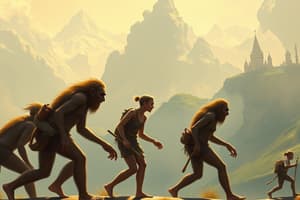Podcast
Questions and Answers
What was a significant reason for H sapiens to outperform H neanderthalensis in terms of survival strategies?
What was a significant reason for H sapiens to outperform H neanderthalensis in terms of survival strategies?
- Hn had a higher basal metabolic rate.
- Hn could consume a completely meat-based diet.
- Hs relied on untailored clothing made from animal hides.
- Hs utilized advanced stone tools with projectile capabilities. (correct)
What dietary component is believed to have been a necessity for H neanderthalensis?
What dietary component is believed to have been a necessity for H neanderthalensis?
- Cooked vegetables only.
- Sugar-based foods.
- A raw plant component. (correct)
- Only meat-based diets were sufficient.
Which of the following describes the shelter-building practices of H sapiens?
Which of the following describes the shelter-building practices of H sapiens?
- They created more advanced and efficient hearths and shelters. (correct)
- They primarily used caves for shelter.
- They avoided constructing shelters altogether.
- They built inefficient shelters that wasted energy.
How did the arrival of H sapiens impact predator competition?
How did the arrival of H sapiens impact predator competition?
What evidence suggests that H sapiens hunted cave bears?
What evidence suggests that H sapiens hunted cave bears?
What contributed to the decreased remains of bears in archaeological sites as human populations increased?
What contributed to the decreased remains of bears in archaeological sites as human populations increased?
Which of the following innovations is associated with the complex material culture of Homo sapiens during the Aurignacian period?
Which of the following innovations is associated with the complex material culture of Homo sapiens during the Aurignacian period?
What were some disadvantages faced by Neanderthals compared to Homo sapiens?
What were some disadvantages faced by Neanderthals compared to Homo sapiens?
The resource overlap hypothesis suggests that Neanderthals went extinct due to competition with which species?
The resource overlap hypothesis suggests that Neanderthals went extinct due to competition with which species?
What critical lesson does the Neanderthal extinction provide concerning modern environmental challenges?
What critical lesson does the Neanderthal extinction provide concerning modern environmental challenges?
Which characteristic contributed significantly to the success of Homo sapiens in resource management?
Which characteristic contributed significantly to the success of Homo sapiens in resource management?
What type of tools did early humans innovate to respond to environmental challenges?
What type of tools did early humans innovate to respond to environmental challenges?
Which of the following adaptive strategies is reflected in the success of Homo sapiens over Neanderthals?
Which of the following adaptive strategies is reflected in the success of Homo sapiens over Neanderthals?
Which of the following factors contributed to H neanderthalensis requiring more energy than H sapiens?
Which of the following factors contributed to H neanderthalensis requiring more energy than H sapiens?
H sapiens did not need a plant component in their diet to survive.
H sapiens did not need a plant component in their diet to survive.
What type of tools did Homo sapiens develop that improved their hunting efficiency?
What type of tools did Homo sapiens develop that improved their hunting efficiency?
The cave bears, primarily herbivores, competed with humans for ________.
The cave bears, primarily herbivores, competed with humans for ________.
Match the following adaptations with the corresponding species:
Match the following adaptations with the corresponding species:
What was a key element of Homo sapiens' material culture during the Aurignacian period?
What was a key element of Homo sapiens' material culture during the Aurignacian period?
Neanderthals relied primarily on projectile weapons for hunting.
Neanderthals relied primarily on projectile weapons for hunting.
What term describes the hypothesis that explains Neanderthal extinction due to competition with Homo sapiens?
What term describes the hypothesis that explains Neanderthal extinction due to competition with Homo sapiens?
Neanderthals faced disadvantages due to their high __________ demands.
Neanderthals faced disadvantages due to their high __________ demands.
Match the following elements with their relevance to early human culture:
Match the following elements with their relevance to early human culture:
How did Homo sapiens adapt their resource management compared to Neanderthals?
How did Homo sapiens adapt their resource management compared to Neanderthals?
Cave bears remained a common find in archaeological sites as human populations increased.
Cave bears remained a common find in archaeological sites as human populations increased.
What quality was essential for the success of Homo sapiens in their environment?
What quality was essential for the success of Homo sapiens in their environment?
Flashcards
Hn metabolic needs
Hn metabolic needs
Humans (Homo neanderthalensis) had higher metabolic needs due to larger size and colder climates, requiring more energy than Homo sapiens.
Hs hunting strategies
Hs hunting strategies
Homo sapiens used long-distance projectile weapons, reducing physical risk and increasing hunting efficiency.
Resource competition
Resource competition
Both Homo neanderthalensis and Homo sapiens competed for resources, particularly large herbivores like reindeer and mammoths.
Homo Sapiens' clothing
Homo Sapiens' clothing
Signup and view all the flashcards
Cave bear competition
Cave bear competition
Signup and view all the flashcards
Aurignacian period
Aurignacian period
Signup and view all the flashcards
Gravettian period
Gravettian period
Signup and view all the flashcards
Neanderthal Disadvantages
Neanderthal Disadvantages
Signup and view all the flashcards
Resource overlap hypothesis
Resource overlap hypothesis
Signup and view all the flashcards
Human Adaptability
Human Adaptability
Signup and view all the flashcards
Rigid Subsistence Strategies
Rigid Subsistence Strategies
Signup and view all the flashcards
Hs success
Hs success
Signup and view all the flashcards
Archaeological Hypothesis testing
Archaeological Hypothesis testing
Signup and view all the flashcards
Hn higher metabolic needs
Hn higher metabolic needs
Signup and view all the flashcards
Hs projectile weapons
Hs projectile weapons
Signup and view all the flashcards
Competition for Resources
Competition for Resources
Signup and view all the flashcards
Hn clothing disadvantages
Hn clothing disadvantages
Signup and view all the flashcards
Cave Bear Competition
Cave Bear Competition
Signup and view all the flashcards
Neanderthal Disadvantages
Neanderthal Disadvantages
Signup and view all the flashcards
Hs Adaptability
Hs Adaptability
Signup and view all the flashcards
Rigid Subsistence
Rigid Subsistence
Signup and view all the flashcards
Resource Overlap
Resource Overlap
Signup and view all the flashcards
Hs Innovations
Hs Innovations
Signup and view all the flashcards
Archaeological Hypothesis Testing
Archaeological Hypothesis Testing
Signup and view all the flashcards
Hs Success Factor
Hs Success Factor
Signup and view all the flashcards
Human-Environment Interactions
Human-Environment Interactions
Signup and view all the flashcards
Study Notes
Pat Shipman's "The Invaders" - Chapters 9 & 10
-
Human Expansion: Homo sapiens expanded into Europe around 40,000 years ago, impacting ecological systems. Arrival led to shifts in predator-prey dynamics.
-
Competition and Resource Use: Humans and their wolf-dog relations heightened competition, increasing pressures on other species.
-
Metabolic Needs: Homo neanderthalensis (Hn) had higher Basal Metabolic Rates (BMR) than Homo sapiens (Hs) due to larger bodies and colder climates demanding more energy. Pregnant Homo neanderthalensis women needed 5,500 calories daily.
-
Dietary Needs: A predominantly meat-based diet was insufficient. Homo neanderthalensis likely incorporated plant materials, though fossils rarely preserve these.
-
Stone Tool Technologies: Homo neanderthalensis relied on hand-held tools for close range ambush hunting. Projectile weaponry was less developed compared to Homo sapiens.
-
Ecological Impact: Both species competed for large herbivores, like reindeer and mammoths, leading to competition within predator guilds. Extinction of Homo neanderthalensis may have been partially due to resource competition, climate change, and limited technological adaptability.
-
Adaptations & Competition: Homo sapiens adapted with tailored clothing, better shelters, and more efficient hunting techniques. This allowed Homo sapiens to successfully compete with other species and Neanderthals for resources.
-
Limitations of Homo neanderthalensis: Homo neanderthalensis had high metabolic needs and relied on less advanced hunting techniques, making them vulnerable in resource competition and challenging environments.
-
Cave Bear Interactions: Homo sapiens hunted cave bears, while evidence exists of competition for resources within cave habitats.
Contemporary Relevance and Challenges
-
Climate Change Challenges: Homo neanderthalensis's reliance on specific prey impacted their ability to adapt to environmental changes. Their inflexible diet made them vulnerable.
-
Human Adaptability: Homo sapiens's ability to adapt their diets and innovate tools mirrors the need for flexible responses to present-day climate concerns.
-
Invasive Species Concepts: Humans, as invasive species, are comparable to other species that disrupt existing ecological balance.
-
Cooperation and Resource Management: Homo sapiens's success involved cooperation, innovation, and adaptability, highlighting the importance of these factors to sustain resources. Community-based resource management can provide lessons for future sustainability.
-
Key Takeaways: Adaptability, innovation, and cooperation are crucial for survival, both historically and in relation to modern environmental challenges.
Studying That Suits You
Use AI to generate personalized quizzes and flashcards to suit your learning preferences.





